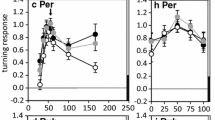Summary
FemaleAcheta domestica did not discriminate between pairs of model calling songs (CSs) which differed only in syllable period (SP; Fig. 1). The females selected the louder CS (Fig. 2) or the CS with a faster chirp rate (CR; Fig. 3) when presented with pairs of otherwise identical CSs. A CS with an SP of 50 ms (modal for the male's CS) was preferred when it was 5 dB louder than one with a 60-ms SP while a CS with a 60-ms SP was only consistently chosen when it was 10 dB louder than a CS with a 50-ms SP (Fig. 4). A more intense CS was preferred by the females regardless of whether its CR was faster or slower than that of the CS produced at a lower intensity (Fig. 6). When CSs with SPs of 50 or 60 ms had several different CRs, the females that made a significant choice preferred a CS with a 50-ms SP regardless of whether it was produced at a faster or slower CR (Figs. 7, 8). No significant selection between CSs with 40- and 50-ms SPs resulted when they were produced at different intensities (Fig. 5) or CRs (Fig. 9). Females only significantly chose a CS with a 50-ms SP over those with 40 ms SPs when the 50-ms-SP CS was louder and produced at a different CR (Fig. 10). From these results, it was apparent that SP, intensity, and CR all influenced a female's choice of a CS, and thus the male producing it. However, our results indicate that SP was the most important feature influencing the female's choice and that intensity was more effective than CR.
Similar content being viewed by others
Abbreviations
- CR :
-
chirp rate
- CS :
-
calling song
- POD :
-
polar orientation diagram
- SP :
-
syllable period
References
Atkins G, Atkins S, Schoun D, Stout JF (1987) Scototaxis and shape discrimination in the female cricketAcheta domesticus in an arena and on a compensatory treadmill. Physiol Entomol 12:125–133
Doherty JA (1985a) Trade-off phenomena in calling song recognition and phonotaxis in the cricket,Gryllus bimaculatus (Orthoptera, Gryllidae). J Comp Physiol A 156:787–801
Doherty JA (1985b) Phonotaxis in the cricket,Gryllus bimaculatus DeGeer: comparison of choice and no-choice paradigms. J Comp Physiol A 157:279–289
Doolan JM, Pollack GS (1985) Phonotactic specificity of the cricketTeleogryllus oceanicus: intensity-dependent selectivity for temporal parameters of the stimulus. J Comp Physiol A 157:223–233
Murphey RK, Zaretsky MD (1972) Orientation to calling song by female crickets,Scapsipedus marginatus (Gryllidae). J Exp Biol 56:335–352
Pollack GS, Hoy RR (1979) Temporal pattern as a cue for species-specific calling song recognition in crickets. Science 204:429–432
Popov AV, Shuvalov VF (1977) Phonotactic behavior of crickets. J Comp Physiol 119:111–126
Popov AV, Shuvalov VF, Svetlogorskaya ID, Markovich AM (1975) Acoustic behavior and auditory systems in insects. In: Schwartzkopff J (ed) Mechanoreception (Symposium). Abh Rhein-Westf Akad Wiss 53:281–306
Schildberger K (1984) Temporal selectivity of identified auditory neurons in the cricket brain. J Comp Physiol A 155:171–185
Schmitz B (1985) Phonotaxis inGryllus campestris L. (Orthoptera, Gryllidae). III. Intensity dependence of the behavioural performance and relative importance of tympana and spiracles in directional hearing. J Comp Physiol A 156:165–180
Stout JF, Gerard G, Hasso S (1976) Sexual responsiveness mediated by the corpora allata and its relationship to phonotaxis in the female cricket,Acheta domesticus L. J Comp Physiol 108:1–9
Stout JF, DeHaan CH, McGhee RW (1983) Attractiveness of the maleAcheta domesticus calling song to females. I. Dependence on each of the calling song features. J Comp Physiol 153:509–521
Stout JF, Atkins G, Weber T, Huber F (1987) The effect of visual input on calling song attractiveness for femaleAcheta domesticus L. Physiol Entomol 12:135–140
Thorson J, Weber T, Huber F (1982) Auditory behavior of the cricket. II. Simplicity of calling-song recognition inGryllus, and anomalous phonotaxis at abnormal carrier frequencies. J Comp Physiol 146:361–378
Weber T (1978) Vergleich der Lockgesänge von drei Grillenarten im Hinblick auf artspezifisches Erkennen in der Phonotaxis der Weibchen. Verh Dtsch Zool Ges 71:176
Weber T, Thorson J, Huber F (1981) Auditory behavior of the cricket. I. Dynamics of compensated walking and discrimination paradigms on the Kramer treadmill. J Comp Physiol 141:215–232
Author information
Authors and Affiliations
Rights and permissions
About this article
Cite this article
Stout, J.F., McGhee, R. Attractiveness of the maleAcheta domestica calling song to females. J. Comp. Physiol. 164, 277–287 (1988). https://doi.org/10.1007/BF00603958
Accepted:
Issue Date:
DOI: https://doi.org/10.1007/BF00603958




